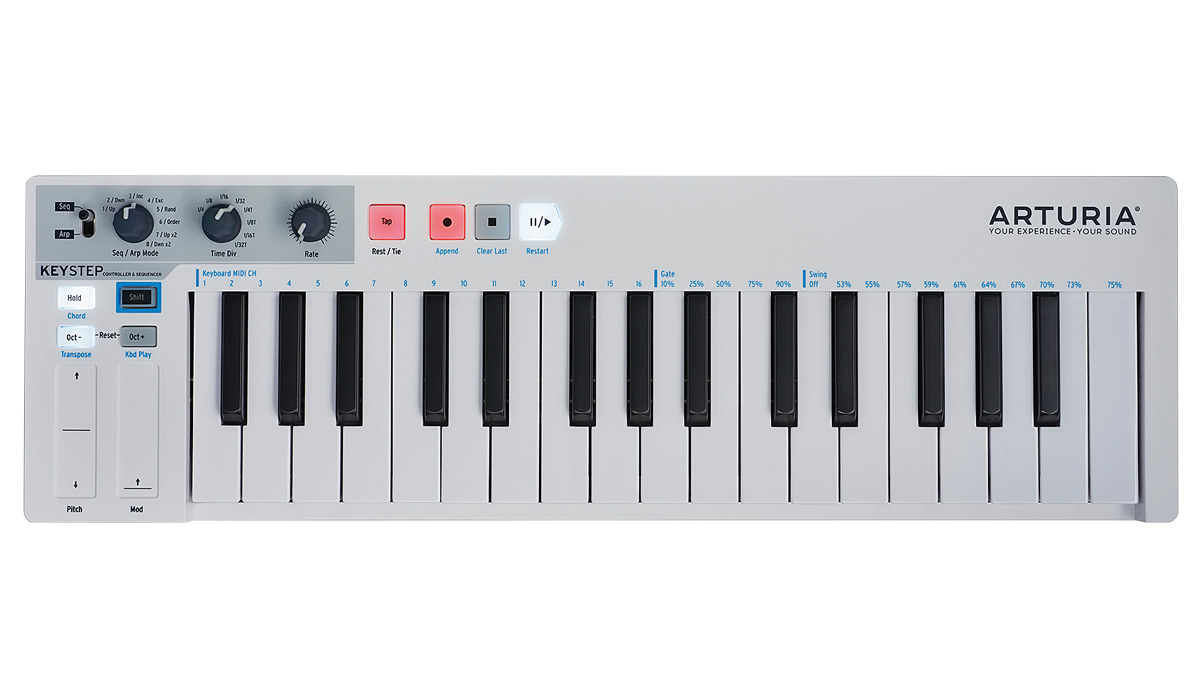MusicRadar Verdict
With lots of functionality and flexibility packed into a convenient and affordable package, the KeyStep gets a big thumbs-up.
Pros
- +
Flexible range of digital and analogue ins and outs. Compact, light and very portable.
Cons
- -
No power supply in the box.
MusicRadar's got your back
Coming in the wake of last year's excellent, multifaceted BeatStep Pro, Arturia's latest controller - a simple-looking, 32-note mini keyboard - might look a little underwhelming at first glance.
However, for a sub-£100 controller, the KeyStep packs in a surprising amount of functionality and an impressive number of well-designed features.
As with the two 'Steps' that preceded it, the KeyStep features a range of different I/O formats. There's a USB connection, for hooking the controller up to a computer, MIDI In and Out ports and CV Pitch, Gate and Mod outputs. There are also mini-jack Sync In/Out ports, which will work with pulse clock devices, such as Korg's Volca range, or can send and receive DIN Sync messages via a (separately purchased) adaptor.
Arturia's MIDI Control Centre software allows for further configuration of the outputs too, including setting the CV outputs to volts per octave or hertz per volt and adjusting sync settings. Finally, a sustain pedal input and power input round off the connections.
The hardware itself is fairly lightweight, consisting of a metal base with a plastic top and rubber controls. The keys are a 'slim' design, but are velocity and aftertouch sensitive and are fairly playable for a controller this size.
It's far from cumbersome and easy enough to squeeze onto even a small desk alongside a laptop.
The keys are joined by a pair of touchstrips that handle pitch and modulation and, while these offer nothing in the way of visual or tactile feedback, they're conveniently placed and nice to use. The KeyStep has clearly been designed with portability in mind though, and on that front it excels. At just under 50cm long and 15cm deep it's far from cumbersome and easy enough to squeeze onto even a small desk alongside a laptop.
Sequencer and arp
To call KeyStep a keyboard controller only tells a fraction of the story though.
Alongside its standard MIDI keyboard functions, the KeyStep also features a built-in polyphonic sequencer, arpeggiator and chord mode. The sequencer has an eight-pattern memory, which comes pre-loaded with patterns but can be overwritten by user input.
Each pattern can have up to 64 steps, with a maximum of eight notes per step. Notes can be inputted 'offline' step-by-step, with a button for adding rests and tie notes. Sequences can be recorded or replaced in real time too, simply by hitting play and record.
There are Append and Clear Last functions too, for adding or removing steps from the end of a sequence. While the hardware itself only offers eight sequence slots, it's possible to save and load an unlimited amount via the MIDI Control Centre software, where users can also create sequences via a piano roll and upload them to the device.
The arpeggiator, meanwhile, offers eight patterns, including a Random mode and a user-defined Order mode. The tempo and timing of the sequencer and arpeggiator are controlled by Rate and Note Division rotaries along the top of the KeyStep, the latter of which offers eight rhythmic delineations.
The tempo of both can be sync'd via any of the rear inputs, with the clock source selected via a pair of small, indented switches on the rear of the unit. These switches are actually one of the KeyStep's few design missteps - they're small and fiddly, and tucked away in a position that's awkward to access without picking the controller up and turning it over.
Beyond these, there are a few other features accessible via the Shift button. With Shift pressed, the keybed is used to select the MIDI output channel as well as control gate length and swing.
Having gate and swing controls up front like this is actually a nice little touch, providing a quick way to add subtle rhythmic variation to sequences on the fly. Shift also gives access to a Transpose mode and Keyboard Play, which allows the keyboard to play notes via the MIDI output and output a sequence via CV simultaneously.
Aside from the fiddly clock selectors mentioned above, our only real gripe with the KeyStep is the fact it ships without a power adaptor. Obviously, this isn't uncommon these days - and the KeyStep can function via USB power - but it does mean that, straight out the box, it can't be used without a computer, which is a shame for a device that boasts of its standalone CV and MIDI credentials.
It's an extra expense to take into account, rather than a deal breaker. With this much functionality packed into a portable and convenient controller keyboard, all for less than £100, the KeyStep is easy to recommend.
I'm the Managing Editor of Music Technology at MusicRadar and former Editor-in-Chief of Future Music, Computer Music and Electronic Musician. I've been messing around with music tech in various forms for over two decades. I've also spent the last 10 years forgetting how to play guitar. Find me in the chillout room at raves complaining that it's past my bedtime.
“I used everything I knew about music”: How Green Day exceeded expectations with their most ambitious song
YouTube just added AI tools that makes musicians, library music and video editors redundant
“Every one of them said yes without hesitation": Hank Marvin and Roger Taylor have just remade a '60s classic for charity










